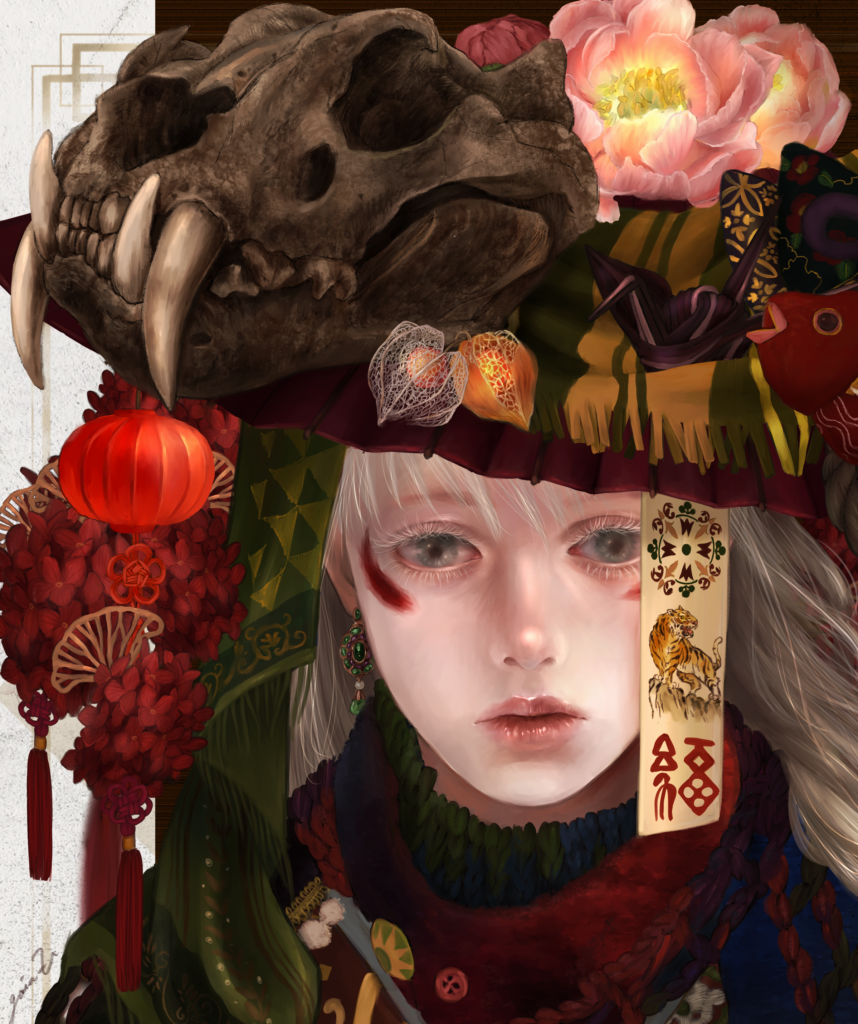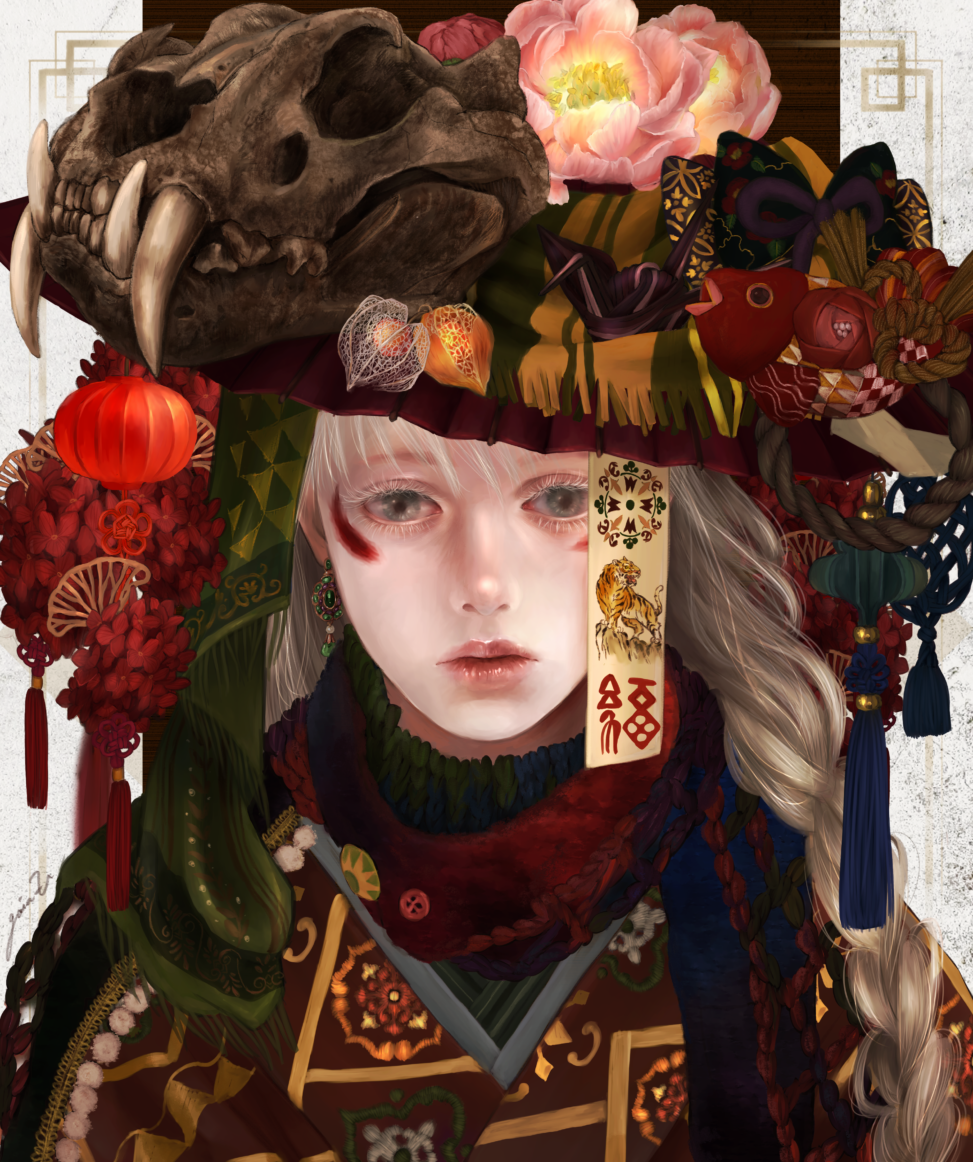
description
どうかわたしを恐れないでほしい。
肌と髪をはいで、目玉をくりぬけば、
きっと同じ赤い血液と、体を構成する骨と肉が見えるでしょう。
どうか死後はその隊列に入れてほしい。
魂には種類も品格も隔たりもないのだから。
Please don’t be afraid of me.
When you rip off my skin and hair and gouge out my eyeballs,
you will see the same red blood, the same bones and flesh as me.
I beg you to place me in your ranks after my death.
Because souls are equal and there should be no race, no dignity, no separation.
あとがき
アジアの衣装を纏った西洋の顔立ちの女性。とても異質でアンバランスな作品に仕上がったなと感じています。
彼女はとある異民族の末裔です。
彼女の民族は狩猟や漁労、補助的に農業を行って暮らしていました。
しかしその土地の開拓使により 生活の場が奪われ、食料不足による餓死者や生活の変化で、その少数民族は息絶えてしまいました。
とうとう人里離れた村でひとりぼっちになってしまった彼女は、
自分より体の小さな、黒い髪と目をもつ民に助けを求めます。
頭につけた鬼灯(ほおずき)が枯れ始めているので、季節は秋の始まりでしょう。
来たる厳しい冬に備蓄を揃えたいのですが、彼女ひとりでは心もとありません。
彼女は精一杯その民の文化に寄せて着飾り、友好を図りました。
字も言葉も分からないので、生業である狩猟を絵で描いて伝えようとしています。(札の絵は上から網、獣、福の文字を絵にしたもの)
鶴は平和を、吊るし飾りは 中国のものを参考にしており、永遠を意味しています。
頭につけた獣の骨や 魚の飾りは、彼女の民族の狩猟技術の高さと知恵を象徴しています。
ですが周囲は、目も肌も髪の色も違う彼女がとても恐ろしく野蛮に見え、畏怖の対象として迫害しました。

今回の異質な組み合わせは、差別と 滅びゆく少数民族をテーマにしています。
タイトルの「聖者」は亡くなった人を指しています。
仏教でも 亡くなると仏になると言うので、死後を神聖化するのはあまり文化上でも隔たりのない概念なのかもしれませんね。
つまり彼女は生きて冬を越せなかったということです。
頭につけている牡丹の花は、日本の三大怪談のひとつ「牡丹灯籠」からインスパイアされています。
恋仲になった男性を想うあまり、牡丹の灯籠を携えて、夜な夜な逢いに来る幽霊の物語です。今回の作品に悲恋の要素は特にありませんが、牡丹の灯籠がロマンチックで可愛かったので描きました。
美しい花が明かりとなって、死後の彼女の世界を明るく照らしてくれることを願っているのです。
https://foundation.app/@gaia-U/gaia-u-tales/6
afterword
A woman with a Western face wearing an Asian costume. I feel that the work is very different and unbalanced.
She is a descendant of a tribe of a different people.
Her people lived by hunting, fishing, and a little agriculture.
However, the pioneers of the area took away their livelihoods, and the ethnic minorities died of starvation due to lack of food and changes in their lifestyles.
Finally, the last survivor, she asked for help from her people, who were smaller than she was, with dark hair and eyes.
The season would be around autumn, as the demon lanterns are beginning to die.
She would like to stock up on food for the winter, but very worried about her being alone.
She imitated the costumes of its dark-haired folk and showed friendship.
Since she did not know how to write, she would draw pictures to tell people how to hunt.[The picture on the bill is a picture of the Chinese characters for net, beast, and good fortune from the top.]
The crane represents peace, and the hanging ornaments are inspired on Chinese ones and mean eternity.
The animal bones and fish ornaments on the head symbolize the strength and wisdom of the her hunting.
However, people around her, who had different eyes, skin, and hair color, saw her as a very scary and barbaric person, and persecuted her as an object of awe.

The themes of this unbalanced work are discrimination and dying minorities.
The title, ” Saint,” refers to a deceased person.
Since Buddhism says that when one dies, one becomes a Buddha, it may be an inseparable concept that the departed soul is sanctified.
In other words, she did not make it through the winter alive.
The peony flower on her head was inspired by “Peony Lantern,” one of the three most famous ghost stories in Japan.
It is the story of a ghost who thinks of the man she loved and comes to see him every night with a peony lantern.
Although there is no element of tragic love in this work, I hope that the beautiful flowers will serve as a light to brighten her world after her death.


75件のコメント
75件のピンバック